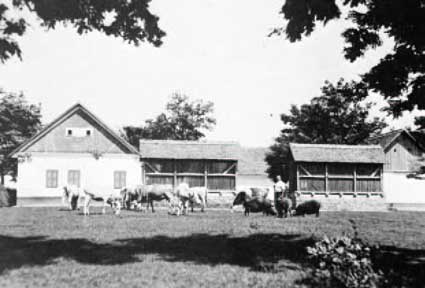 Sallasch (Meierhof) of Nikolaus Weber with Hambars |
 Sallasch (Meierhof) of Nikolaus Weber with Hambars |
It has almost disappeared from the rural picture of the deep plain. Each private fortune was expropriated without replacement by the Communist collective and transferred into state property. The numerous living and work buildings of the private Lords of manors were superfluous, after which the large central state property was managed. And besides that one aimed at gaining more land capable of being cultivated by burning these Sallasch buildings to the ground. Have these enormous rural revolutions in the eastern and southern part of our continent brought the success hoped for? - No! We know today that the expropriation of the private rural businesses and the creation of huge state properties in the Communist lands concerned - just like the communist ideology itself - failed completely.
Reprivatization in the concerned lands was necessary so there should be an economical upswing again. Yet this alone did not bring political reform, reached through changes in the constitution and the creation of relevant laws. What was not less necessary was the return of each rural structure which the concerned states were once the foundation of a solid prosperity was to some extent a good sign that the Sallasch also belonged in private hands. A replacement construction of the destroyed buildings required a high financial expenditure, yet there was no money.
Was it ever successful again to bring about the former condition? It was also the wish of the people of our former homeland to have a claim and a right to a better living relationship.
Our only memory remaining is that of the wide flat land from which a well put together system in the middle of fruitful fields from which arose numerous yards and gave each observer customers from it, so that there was not only shelter for people, livestock and appliances managed, but also fostered the rural culture. And mingled in our memory - like a last greeting from that world of our beneficial work - the fall fragrance in the broad stubble fields on which we grew our daily bread, on which our whole pride walked.
Fulfilled life's fortune that still lives on in memory!
In the Batschka pig breeding, horse breeding, beef cow breeding, sheep and goat breeding, poultry breeding, bee breeding, silk caterpillar breeding, and small animal breeding, were more or less intensively pursued.
The livestock breeding went through a structural change since 1730. In place of extensive livestock breeding with meadows, intensive livestock breeding with stable feed was introduced. The conversion in field cultivation did not mean there was a problem with the livestock breeding, but their transformation.
Feed for the livestock breeding: corn, barley, bran, mangelwurzel (beet?), sugar beet scraps, corn husks and clover, in addition to pumpkin, Häcksel (reduced straw and chaff), and green feed (feed corn, oats, and sweet peas). Vaccinations regularly took place. The vaccines were produced in the “Kamendin” state bacteriological institute in the neighborhood of Neusatz. In the Hungarian part of the Batschka they were obtained from Budapest.
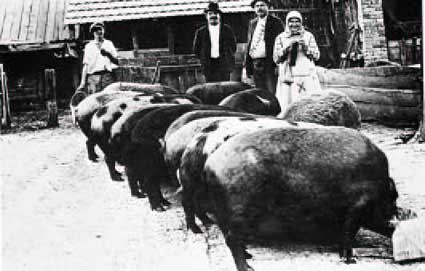 |
PIG BREEDING - The most well known breeds were: Mongolica (lard and spotted), Bahonyer (lard), Yorkshire,and Berkshire (meat), refined land pigs (its adaptation to the climate of the land was not completely fortunate) and the Pfeiffer (pepper) breed (a very suitable fat and meat pig). |
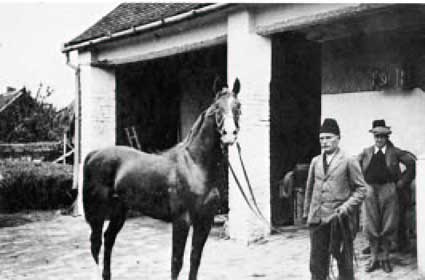 |
HORSE BREEDING - Originally the Arabian full-blooded and the Hungarian steppe horse dominated. With the conversion of the agriculture draft and field animals were demanded. In 1816 the stallion "Nonius" came from a French stud farm for a "Mesöhegyes" stud farm. By crossing with a local breed the "Nonius-horse" came into being. More stud farms existed in Baja and between Palanka and Bukin (erected after 1918).The Horse breeding cooperative bought full-blooded stallions from the state, just as studs, whose proof of suitability was confirmed with its brand and certificate. |
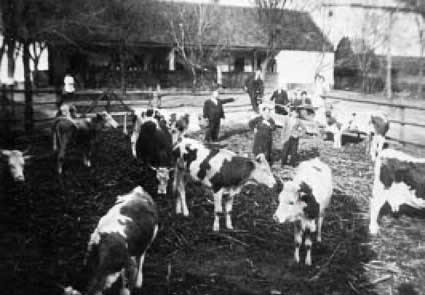 |
CATTLE BREEDING - It was carried out by crossing between the long horned white Hungarian steppe cattle and the Simmen Valley, Allgäuer, and Oberinn Valley animals. One placed great value on milk, cheese, and butter. |
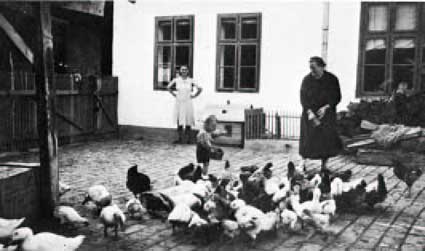 |
POULTRY BREEDING - Almost in all homes there were chickens, geese, ducks, turkeys, guinea fowl, etc. Often the housewife hardly knew how many chickens she had. The poultry were slaughtered for household needs or sold at the weekly market. |
SHEEP AND GOAT BREEDING - They are forever lost in importance. In 1939 there were still only 753 goats. The number of sheep took just the same course.
BEE AND SILKWORM BREEDING - Both were formerly of great Importance. In the middle of the 19th century there Were for example still 30,000 beehives and 500,000 mulberry trees whose leaves nourished the silkworms and around 500,000 kilograms of silk cocoons. Since the turn of the century bee and silkworm breeding have picked up even more.
SMALL ANIMAL BREEDING - Rabbits and pigeons belong here.The small animal breeding were of limited
economical importance.
Pets were less of a luxury than an assistance to people. The dogs guarded the properties (living quarters and Sallasch), the cats killed the mice.